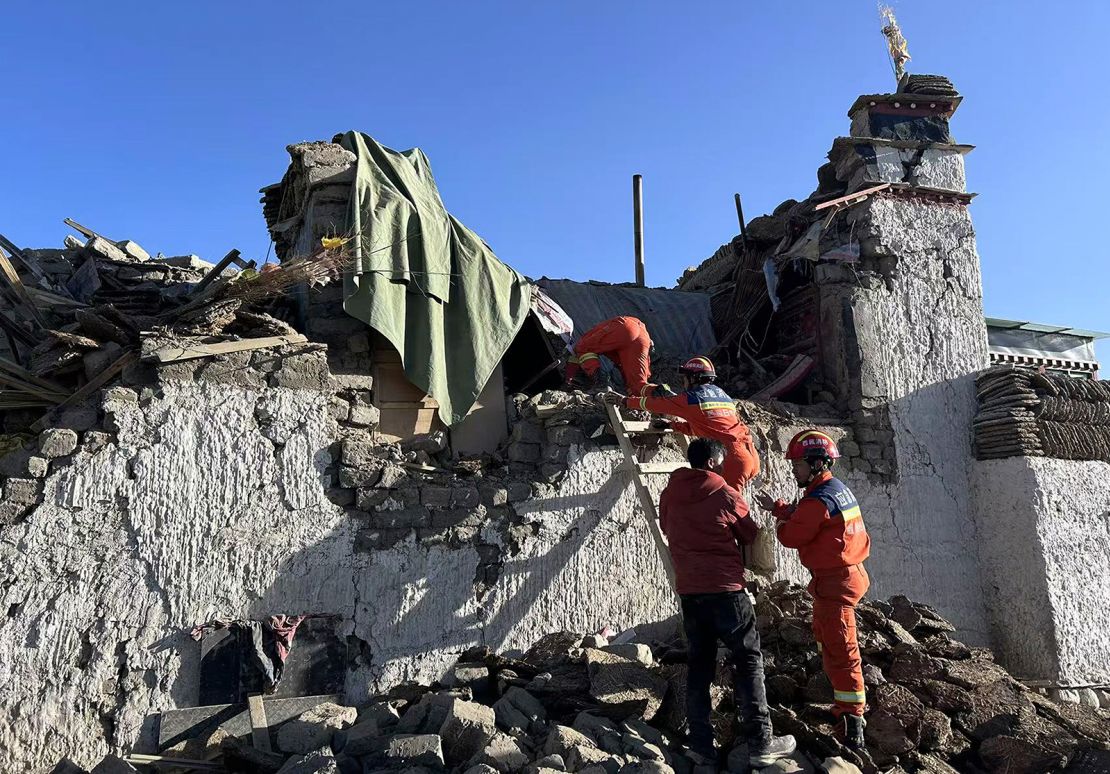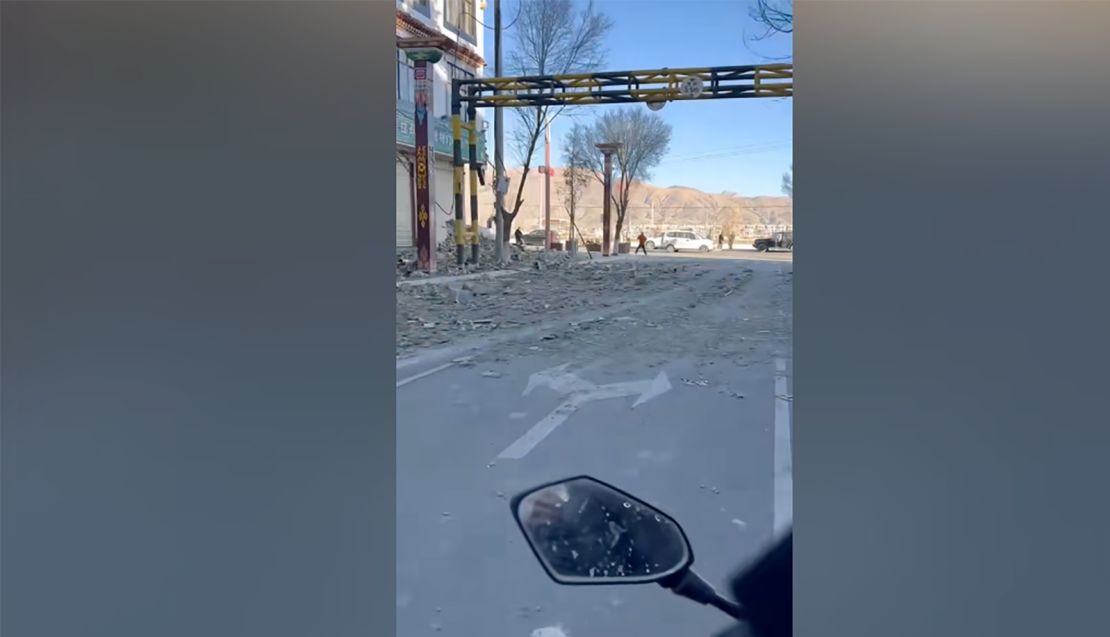Hong Kong
CNN
—
A strong earthquake struck a remote region of Tibet on Tuesday morning, killing more than 120 people and shaking it felt across the Himalayas in neighboring Nepal, Bhutan and parts of northern India.
The magnitude 7.1 earthquake struck at 9:05 a.m. local time at a depth of 10 kilometers (6.2 miles) and was followed by multiple aftershocks, according to the US Geological Survey (USGS).
The energy unleashed by the tectonic movement toppled houses in remote Himalayan villages, shook the nearby holy city of Tibet and rattled tourists visiting Mount Everest’s base camp.
At least 126 people were killed and 188 injured in the quake, state broadcaster China Central Television (CCTV) said. More than 3,600 homes were reportedly damaged.
The epicenter was in Tingri province on the Tibetan Plateau, near the border with Nepal and about 80 miles north of the world’s highest mountain.
The tremors were felt as far away as Kathmandu, the capital of Nepal. “It was very strong. People were running out of their houses. You could see the power lines from the poles shaking and coming loose,” said Vishal Nath Upreti of the Nepal Disaster Management Center, a non-governmental organization in Kathmandu. spoke.
In Tibet, a massive rescue operation by emergency services and the Chinese military has rescued more than 400 people trapped under rubble. More than 30,000 residents have been relocated as rescue teams continue to search for survivors, authorities said.
Areas near the epicenter are sparsely populated, but small villages dot the isolated and inaccessible Himalayan valleys. According to Xinhua News Agency, an estimated 6,900 people live in 27 villages within a 20km radius of the epicenter.
State media footage showed the remains of collapsed houses and crumpled walls littering villages at the foot of the mountain, with rescue workers digging through the rubble with their bare hands to search for survivors. Ta.
Videos from Chinese social media, geolocated by CNN, showed damaged roofs, storefronts and piles of debris piled up on streets in Latse province, about 86 kilometers from the epicenter. According to footage, some cars and motorcycles parked along the road were also damaged.
The closest major city to the epicenter is the holy city of Shigatse, about 180 kilometers (111 miles) away. The city is home to about 800,000 people and is the traditional sacred site of the Panchen Lama, Tibetan Buddhism’s second-highest spiritual leader after the Dalai Lama.
His Holiness the Dalai Lama, who lives in self-imposed exile in India, said he was “deeply saddened” to learn of the earthquake. “I pray for the repose of the souls of those who lost their lives, and I pray for the speedy recovery of those who were injured,” he said.
Surveillance camera footage from a supermarket in Shigatse shared with Xinhua captured the moment the quake struck, showing customers running outside as products fell from shaking shelves. There were no immediate reports of widespread damage in the city.
Pu Chi, who lives in Bainan province, about 200 kilometers (125 miles) from the epicenter of Tingri, was lying in bed on Tuesday morning when she felt her room shake and the lights on the ceiling started shaking. He said he saw it.
“I was really scared so I quickly got dressed, ran outside and called my family to let them know,” Pooh, 24, told CNN. She said it was her first time experiencing an earthquake.
The China Meteorological Administration warned local residents to take shelter from the cold and wind as temperatures are expected to dip below 0 degrees Fahrenheit (-18 degrees Celsius) over the next two days. The Singatse local government has dispatched thousands of tents, beds and coats to the affected areas.
In a statement after the earthquake, Chinese leader Xi Jinping urged authorities to search and rescue survivors, minimize casualties, properly contain affected residents, and ensure safety and warmth in the winter cold. He called on them to do their best.
More than 1,600 soldiers from the People’s Liberation Army and paramilitary police were sent to help, as well as military drones, helicopters and transport planes.

Everest and Nepal are rattled
Anna Guo, an 18-year-old university student traveling with a tour group, was about to leave Shigatse and head southwest to see Mount Everest on Tuesday morning when the ground started shaking violently.
“As I was waiting in line, I heard some noise and realized it was an earthquake. It got stronger and stronger and the windows started shaking,” she told CNN.
“This is the first time I’ve felt such a strong earthquake.”
Local authorities closed the Everest climbing base camp and surrounding scenic spots on Tuesday. Although winter is not the high season for climbing the world’s highest mountain, some Chinese tourists visit this scenic spot for breathtaking views of the Himalayas.
Ba Luo, a staff member at the base camp, said he felt the earthquake shaking but there was no damage to buildings. He said nearly 500 tourists visited the camp on Monday and about 30 tourists were at the base when the earthquake struck, adding that all tourists were evacuated.


Across the border from the epicenter of the Chinese province, Nepal’s Solukhumbu district was shaken by the tremors of a devastating 7.8-magnitude earthquake that struck near Kathmandu in 2015, killing about 9,000 people and injuring thousands. My memory came back.
“The shaking was very strong. Everyone is definitely panicking,” Rupesh Vishwakarmi, a local district official, told CNN. At a yak farm near Everest’s Nepal base camp, “everything was shaking” and workers were “very scared”.
Nepal Police announced that 13 injured people have been rescued across the country. The Ministry of Interior announced that 10 houses were damaged and one was completely destroyed.
According to the China Earthquake Network Center, more than 500 aftershocks had been recorded by Wednesday evening, 27 of which were of magnitude 3.0 or higher.
Tibet is one of China’s most restricted and politically sensitive regions, and access to foreign tourists remains tightly controlled. Beijing has maintained a tight grip on the region since the Dalai Lama fled to India in 1959 after a failed revolt against Chinese rule.
This story has been updated with additional developments.


